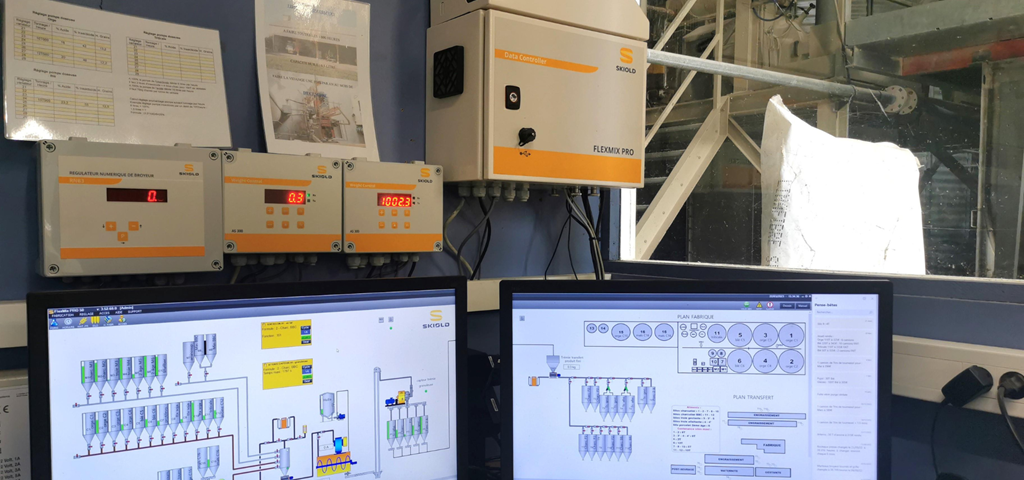
On-farm feed producer for 20 years, "We wouldn't go back".
Why produce your own feed? "We cultivated our own grain. So why not do it from A to Z? There was a margin to gain"
Read what Patrice Maurel, a pig farmer in the Tarn, France has to say. At a time when cereal prices are so volatile, many farmers are thinking about investing in on-farm feed production. Patrice has been a pig farmer for over 20 years. He has been making his own pig feed since 2002. Here is a look back at his experience and the renovation of his on-farm feed mill.
Why your own on-farm feed mill?
It is a combination of factors. Let us just say that we were working with butchers and we already had our own recipe. We also knew some farmers who had their own on-farm feed mills. We cultivated our own grain. So why not do it from A to Z? There was a margin to gain. And at the time, the investment wasn't the same.
So in 2002, we decided to produce our own feed on the farm to make the most of our own raw materials.
How far has on-farm feed production come in 20 years?
We would not go back!
How do you work with on-farm feed production?
Today, we produce 60 tonnes of feed a week, or 3,300 tonnes a year. To feed our pigs, we use 5 recipes for dry feeds:
- Lactating sows
- Gestating sows
- Weaners
- Finishers
- Bleu-blanc-coeur pigs: Specific specifications which imply absence of soya cake. Instead, we use sunflower meal, extruded broad bean and linseed.
We produce our dry feed in pellet form based on our own grain and grain from of our neighbours. Pellets are more palatable than flour and are better assimilated. For the finishers, we have been using the same barley-based formula for 15 years! We get better quality meat.
We only work with artisan butchers: Carcass and cutting. To produce quality carcass and meat, genetics have a lot to do with it, but so does the feed. Producing our feed on the farm allows us to produce meat that fits the carcass. We do not want to produce meat that leaks moist and will not hold up on the carcass.
Production
As far as the time spent on feed production is concerned (30 minutes a day), it is essentially linked to the pellet press. I heat it up gradually and carry out manual tasks. After that, the manufacturing process moves quickly. Everything is automated. You don't have to be there all the time. Once production is complete, the feed is pneumatically transferred to the finished product silos, where I always have a week's supply in advance. The feed is then distributed via a wire chain.
The FlexMix Pro software enables him to define time slots and program production by recipe. In this case, he programs 20 schedules for 5 batches.

Servicing & Maintenance
We dedicate 1 day a month to maintenance, so that we can work in a pleasant environment, which contributes to the durability of the equipment. From time to time, I check and turn the hammers in the mill. Otherwise, since I started, I've just changed a few switches and joints!
"A feed mill needs to be serviced every year by a specialist," explains Jonathan RIO, a technician at SKIOLD, who was involved in replacing the automatic system.
Changes to the feed mill since 2002?
A simple feed mill that develops:
2020: Increase in storage capacity
2021: Change of automation from a Multifarm box to an automated control system with FlexMix Pro computer monitor software
Since then, Patrice has been using and particularly appreciating FlexMix Pro for the following features:
- The stock management
- The hour counters for maintenance
- The remote control
- The PC synoptic
How do you go about changing the automation?
"First of all, if you only want to replace the automatic system, you need to be sure that the feed mill is mechanically sound. If in doubt, the farmer can ask his dealer for a diagnosis. In preparation, it took 1 to 2 days to prepare all the programming and the PC synoptic at SKIOLD. Then, on the farm, the electronics had to be replaced and the silo stocks transferred. During the replacement, the farmer must have a stock of feed in advance (at least 2 days) to continue feeding his animals" explains Jonathan Rio.
Do you have any advice for other farmers wishing to invest in on-farm feed production?
It is a question of making the most of the cereals! Anyone who has the cereal available should do so. They will see that the consumption and growth indices are better with on-farm feed production. With on-farm feed production, the feed has more energy.
Installation by SKIOLD France in collaboration with our dealer ETS Foulquier
Farm information:
- Sorèze, France
- 4 partners and 2 employees
- Pig farming: 340 sows and 3,000 fattening houses, including 1,000 Bleu-blanc-coeur labelled pig house
- UAA: 100 ha
- Production of 60 tonnes of feed per week, i.e. 3,300 tonnes per year.
- Aerofarm ACEMO on-farm feed mill with pelletizer commissioned in 2002: Hammer mill / horizontal mixer / pneumatic transfer
- FlexMix Pro control since 2022
Do you want to make your own feed for pigs? Contact us to find out more about our customisable feed milling solutions:


 English
English
 Danish
Danish
 French
French
 Swedish
Swedish
 Vietnamese
Vietnamese
 Spanish
Spanish
 German
German
 English
English




